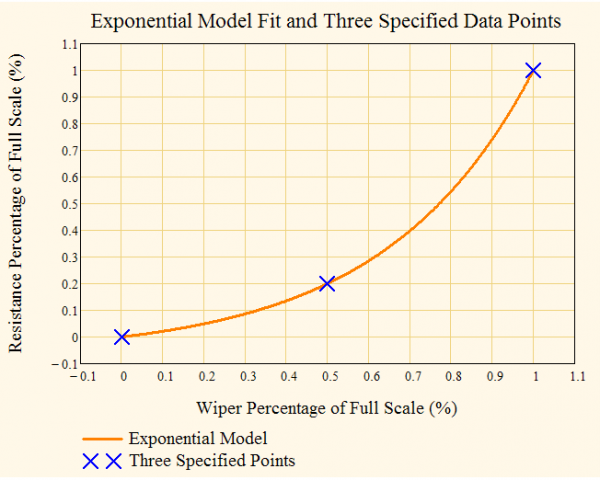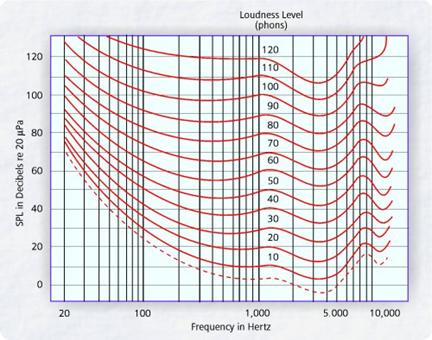Introduction
I have an application where a potentiometer may be useful. In fact, it would be useful if the potentiometer had a logarithmic resistance characteristic, which is also called an audio taper for reasons that I will cover later. I have never used a potentiometer with a logarithmic characteristic before and I thought it would be worth documenting what I learned during this effort.
Background
Logarithmic Misnomer
What is normally referred to as a logarithmic taper is really an exponential characteristic. A typical logarithmic taper potentiometer characteristic is shown in Figure 1 (Source).
Each vendor will have a different "series" label for the logarithmic potentiometers, which often have names like "series A" or "series W." The series designation indicates a different set of resistance curves.
Potentiometer Specifications
Not all vendors include a graph of the resistance characteristics of their logarithmic potentiometers. Many of the vendors include a specification that says something similar to the following quote (source):
The “W” taper attains 20% resistance value at 50% of clockwise rotation (left-hand).
This specification means that the potentiometer has
- 0% of it full scale resistance value with the wiper at 0% of its full scale position
- 20% of it full scale resistance value with the wiper at 50% of its full scale position
- 100% of the total resistance value at 100% of its full scale position.
This type of specification gives you sufficient information to create an exponential curve fit, which I illustrate in Figure 2.
The math associated with this curve fitting is shown in Figure 3.
Equation 1 illustrates the basic form of the logarithmic potentiometer's resistance characteristic R(x), where x is the wiper position as a percentage of full scale.
| Eq. 1 |
where
- R0 is a curve fitting parameter
- R1 is a curve fitting parameter
- x is the wiper position as a percentage of full scale range
Human Hearing
The logarithmic taper is commonly called an audio taper because it is often used audio applications for loudness control. Understanding why involves knowing a little bit about human hearing. Figure 4 (Source) illustrates a human's perception of loudness relative to the Sound Pressure Level (SPL). Sound pressure level is proportional to an audio amplifier's output power. However, the ear is sensitive to the log of the sound pressure level. This is why the "logarithmic" taper is useful.
When people are adjusting the loudness of their audio gear, they prefer that the loudness increase by an amount proportional to amount of dial or slide movement. If a linear potentiometer is used to control output power (and therefore loudness), you will need to use larger and larger amounts of wiper movement to get the same loudness change. To get the same amount of loudness change for a the same amount of wiper movement, the potentiometer resistance needs to increase exponentially.
Compensating for Hearing
Figure 5 shows what how the loudness is perceived by a person as the potentiometer's wiper is moved. You can see that the perceived loudness increases approximately linearly for wiper positions above ~20%.
Conclusion
After all this research, I ended up not using the logarithmic potentiometer because it was not logarithmic. I ended up using another approach which I will discuss in a later post.






Pingback: Another Circuit with a “Logarithmic” Characteristic | Math Encounters Blog
Pingback: Another Circuit with a “Logarithmic” Characteristic | Math Encounters Blog
how do you work out that the tapper position is at 20% Vout at 50% position mathenatically
20% of full-scale resistance at 50% wiper full-scale travel is actually the manufacturer's specification. In Figure 1, I referred to vOUT as defined in the manufacturer's test circuit. The manufacturer applied a voltage to the non-wiper contacts on the pot and measured the percentage of that applied voltage at the wiper.
I made an interactive pot curve using above on
https://www.desmos.com/calculator/9plru2sovy
Drag the slider or the orange point to change values.
Turn on and off curves using the circled square buttons on the left side.
Open folders using the triangles to see equations and comments.
This is pretty cool! What tool did you use to program it?
mathscinotes
That site desmos.com actually provides all (for free), you just have to type the equations and limits and get plots (it's all done in JavaScript, I think). I used wolframalpha.com though and some guess work to figure out how to get the curve parameter at 50% from your numerical solution. You might need to click into the equations to see them fully. See also https://s3.amazonaws.com/desmos/Desmos_Calculator_User_Guide.pdf
Thanks for the reference information. I am very impressed.
mathscinotes
Those graphs look sick! If you could add some notes to explain the meaning of each variable & constant, it would be sweet. I didn't realise Desmos was that powerful, I'm so glad I stumble upon your comment 🙂
This is nice work, there is just one snag. Most commercial 'Audio' pots are not exponential, but piece-wise linear. I suspect the intermediate value quoted in the specs is the 'knee point' and that the behaviour is linear between 0% and the knee and again between the knee and 100%.
A resistor in parallel with a linear pot provides a non-linear response.
No disagreement. Most commercial logarithmic potentiometers are actually piecewise linear. Here is a good visual on the difference in characteristics (source). You can clearly see the two slopes.
I did open up an audio pot years ago. The resistive track had two different widths, which caused the change in the slope of the resistance curve. Unfortunately, I did not take a picture. For this discussion, I was just treating the pots as if they were ideal.
Thanks for writing.
mark
Thanks, was useful for me.
http://oi66.tinypic.com/33lkn07.jpg
Those graphs look sick! If you could add some notes to explain the meaning of each variable & constant, it would be sweet. I didn't realise Desmos was this powerful, I'm so glad I stumbled upon your reply 🙂
Pingback: Akıllı Termostat AHMT v11: İstenen Fatura/Sıcaklık | MuratTatar.xyz